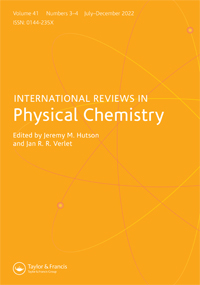超越玻恩-奥本海默理论的光谱和散射过程
IF 2.5
2区 化学
Q3 CHEMISTRY, PHYSICAL
引用次数: 16
摘要
我们回顾了过去15年以来,beyond Born-Oppenheimer (BBO)理论的发展及其在各种模型和实际分子过程中的应用。用从头算彻底地讨论了导致BBO方程的理论公式。我们利用基于第一性原理的BBO理论,不仅建立了单面扩展Born-Oppenheimer方程,以理解非绝热效应的本质,而且还为重要的光谱系统,即NO自由基、Na和K簇、NO自由基、苯和1,3,5-三氟苯自由基阳离子(和)以及三原子反应散射系统(和),构建了精确的非绝热势能面(PESs)。非绝热现象如Jahn-Teller (JT)、Renner-Teller、伪Jahn-Teller效应和偶然的锥形相交是决定光谱和反应散射分布的关键因素。本文在线性和双线性耦合JT模型哈密顿量的背景下,用BBO理论从从头算数据中导出了frank - condon区分子过程的非绝热耦合元的性质。基于BBO的上述分子体系非绝热PESs的量子动力学计算结果与已有的实验结果一致。本文章由计算机程序翻译,如有差异,请以英文原文为准。
Beyond Born–Oppenheimer theory for spectroscopic and scattering processes
We review our development on beyond Born–Oppenheimer (BBO) theory and its implementation on various models and realistic molecular processes as carried out over the last 15 years. The theoretical formulation leading to the BBO equations are thoroughly discussed with ab initio calculations. We have employed first principle based BBO theory not only to formulate single surface extended Born–Oppenheimer equation to understand the nature of nonadiabatic effect but also to construct accurate diabatic potential energy surfaces (PESs) for important spectroscopic systems, namely, NO radical, Na and K clusters, NO radical, benzene and 1,3,5-trifluorobenzene radical cations ( and ) as well as triatomic reactive scattering systems like and . The nonadiabatic phenomena like Jahn–Teller (JT), Renner–Teller, pseudo Jahn–Teller effects and the accidental conical intersections are the key players in dictating spectroscopic and reactive scattering profiles. The nature of diabatic coupling elements derived from ab initio data with BBO theory for molecular processes in Franck-Condon region has been analysed in the context of linearly and bilinearly coupled JT model Hamiltonian. The results obtained from quantum dynamical calculations on BBO based diabatic PESs of the above molecular systems are found to be in accord with available experimental outcomes.
求助全文
通过发布文献求助,成功后即可免费获取论文全文。
去求助
来源期刊
CiteScore
14.20
自引率
1.60%
发文量
5
审稿时长
1 months
期刊介绍:
International Reviews in Physical Chemistry publishes review articles describing frontier research areas in physical chemistry. Internationally renowned scientists describe their own research in the wider context of the field. The articles are of interest not only to specialists but also to those wishing to read general and authoritative accounts of recent developments in physical chemistry, chemical physics and theoretical chemistry. The journal appeals to research workers, lecturers and research students alike.

 求助内容:
求助内容: 应助结果提醒方式:
应助结果提醒方式:


